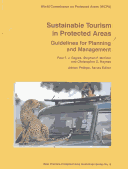Jointly published by UNEP, The World Conservation Unit (IUCN) and the World Tourism Organization (WTO), this text is a contribution to the International Year of Ecotourism 2002. The publication aims to assist protected area managers and other stakeholders in the planning and management of protected areas based on a wealth of practical case studies and experience. The link between protected areas and tourism is as old as the history of protected areas. Protected areas need tourism, and tourism need protected areas. Tourism is essential for the world's economy. A substantial part of Gross Domestic Product (GDP) and employment, especially in developing countries, is related to tourism. Protected areas, such as national parks and wilderness areas, now cover more than 10 per cent of the Earth's surface and play a vital and increasing role in tourism. A key challenge is sustainability - how protected areas can be managed effectively for tourism while ensuring their natural values - the assets that attract tourists - are protected for future generations.
Though the relation between sustainable tourism and protected areas is complex and sometimes adversarial, tourism is always a critical component to consider in the establishment and management of protected areas. Ensuring that tourism follows a sustainable path requires clear leadership and enhanced partnership at all levels, particularly between the tourism industry and relevant government and non-government agencies. This book describes how this can be done.
- ISBN10 2831706483
- ISBN13 9782831706481
- Publish Date 1 January 2003 (first published 26 September 2002)
- Publish Status Unknown
- Out of Print 23 March 2008
- Publish Country GB
- Imprint United Nations Environment Programme
- Format Paperback
- Pages 183
- Language English
